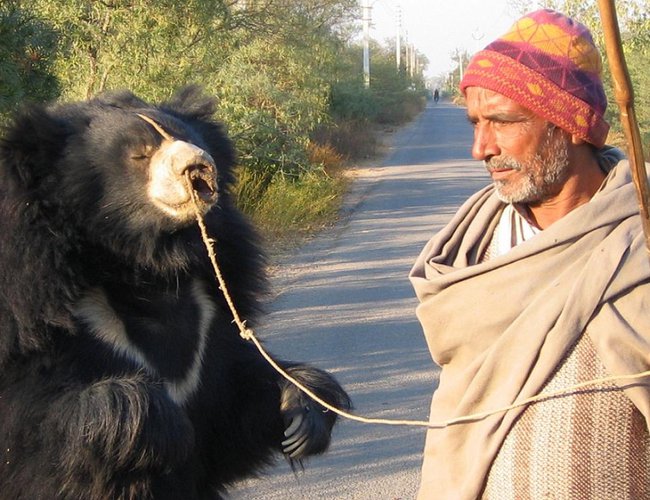
December 19 was the day of freedom for Rangila and Sridevi-the last known dancing sloth bears of Nepal. On that night, both were rescued by the Nepalese police along with the help of the Jane Goodall Institute of Nepal and World Animal Protection, both global wildlife organisations.
The police were able to locate the bears in Iharbari, Nepal by tracking the mobile phone of the bear owners. The rescuers found the bears in an extremely distressed state, showing signs of psychological trauma such as cowering, pacing and paw sucking. The two survivors are now in temporary care of Parsa Wildlife Reserve in Amlekhgunj.
According to a media report, bears like Rangila and Sridevi are snatched from their mother at an early age and forced to perform. Their owner had pierced their nose with a burning hot rod and shoved a rope through it – to retain control of the large animals. Harsh training methods are then used in order to have them submissive enough to perform to tourists.
“Rangila and Sridevi have suffered for too long in captivity since they were poached from the wild. It’s extremely distressing to see animals being stolen from the wild and the sad reality is there are more wild animals suffering across the world, purely for the entertainment of tourists. I am pleased that for these two sloth bears at least; a happy ending is finally in sight,” Neil D’Cruze, Wildlife Expert working with World Animal Protection said.
International media report that while the use of bears in the entertainment industry continues in Pakistan, it has been stopped in Greece, Turkey and India.
Exploitation of bears in Asia is rife in the form of bear-baiting blood sport and in the cruel and unnecessary bear bile industry, where approximately 22,000 Asiatic black bears stuck in tiny cages, with permanent holes in their stomach and constantly milked for their bile. Their bile and gallbladders are dried, powdered and sold as panacea to be used as ‘traditional medicine’.
In Nepal, the practice of performing bears goes back to 1973, but the tradition, an occupation for some street-performing communities, lingered on in parts of its southern region.
Dancing bears are captured and bought as cubs and taught to dance on their hind legs. Their snouts are pierced with a heated rod so they can be controlled by the tug of a rope or chain.
"We are thrilled that the last two known Nepali dancing bears have been rescued from their lifetime of suffering... our hard effort and dedication has helped bring an end to this illegal tradition in Nepal," said Manoj Gautam of the Jane Goodall Institute of Nepal, which worked with the police and World Animal Protection to rescue them.
Dancing bears on the Indian subcontinent date back to the 13th century, when trainers belonging to a tribe that enjoyed royal patronage performed before the rich and powerful. In neighbouring India, the practice came to an end in 2012, decades after an official ban in 1972.
Sloth bears, a critically endangered species, are found in India, Nepal, Sri Lanka and Bhutan. But shrinking habitats and rampant poaching have reduced their numbers, according to the International Union for Conservation of Nature (IUCN).
The IUCN has put them on its red list of threatened species and their total estimated population is 20,000. According to expert, they can grow up to 1.8 meters (six feet) tall and weigh up to 140 kilograms (310 pounds).
- Kathmandu Chronicle: Reclaiming India-Nepal Relations
- Apr 20, 2024
- India Provided Financial Support To Build Schools In Darchula
- Apr 20, 2024
- Iranians Protest After Attack
- Apr 20, 2024
- Weather Forecast: Light Rain Is Likely To Occur At Few Places In Koshi, Bagmati, Gandaki And Karnali Provinces
- Apr 20, 2024
- Japanese Ambassador Kikuta And DPM Shrestha Shared The Views to Deepen Nepal-Japan Bilateral Relations
- Apr 19, 2024
















